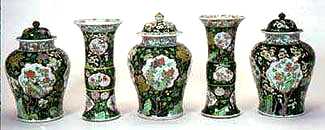
This page is only one of many thousands of Gotheborg.com Help and Information Pages, offering specialized knowledge on Chinese and Japanese Porcelain, including a Glossary, Q&A, Chinese and Japanese Porcelain Marks, Chinese Porcelain Exhibition and Excavation reports etc. For personal help and far more information, join our Discussion Board or use 'Ask a Question' for quick email consultations. For full text and better navigation, use a full-screen device rather than a mobile phone, that offers only limited content.
I would be most grateful for an explanation of the term "garniture." I have been taking a class on antiques and the woman teaching it used this term in reference to a group of five Chinese export pieces arranged across a mantle. I didn't know this term so I looked it up in a regular dictionary and the definition was something like "decorative embellishment." I just dismissed the whole thing until I came across the term again last night in a description of lids for Chinese export porcelain. All the lids had handles formed from some kind of animals. I look forward to you shedding more light on this for me.
 With a "garniture set" one is most often referring to a group of three, five or seven rather large pieces consisting of lidded jars and vases. The jars normally displayed on the flanks. Later "garniture" has come to mean any decorative item used as such in elaborate table settings.
With a "garniture set" one is most often referring to a group of three, five or seven rather large pieces consisting of lidded jars and vases. The jars normally displayed on the flanks. Later "garniture" has come to mean any decorative item used as such in elaborate table settings.
Initially this fashion took hold in Holland, latterly in England at Hampton Court and elsewhere. The fashion for this - and the earliest of these pieces - is from Holland during the Baroque period at the end of the 17th century where a "garniture set" was put on top of huge cabinets.
It is not unlikely that this idea originally comes from the Chinese altar sets which also consists of five pieces. Two beaker vases, two pricket candlestick holders and one joss stick jar to be the centerpiece. How old the Chinese altar sets really are, I don't know but I can off hand remember seeing such from at least the latter part of the Ming dynasty i.e. the 16th century.
The person who made decorating with porcelain into a fashion was the Frenchman Daniel Marot (1661-1752). He was driven from France and established himself as architect at the court of William and Mary in Holland, soon to be crowned King William III and Queen Mary II of England in 1689. He was concerned with all the details of a chic interior and the popularization of the incorporation of porcelain into room detailing was largely his achievement by making printed design leaflets that was widely distributed.
In the beginning of the 18th century the fashion would ask for more but smaller pieces. Larger rooms needed more porcelain. There were 800 pieces in the main room at Kensington Palace in the 1680s and August the Strong of Sachsen considered building an entire palace to display his porcelain collection.
The high fashion of this seems to end by the mid 18th century. From the 19th century we have some of these decorative pieces in Chinese porcelain, normally lidded vases, with animal finals. In the antiques trade these are often called "Palace Jars" since their use is still limited to decoration. The animal in question is often Buddhist "lions", very similar to a small pet dog.
Jan-Erik Nilsson